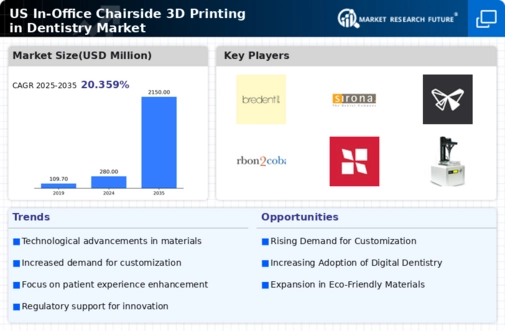Growing Patient Expectations
The in office-chairside-3d-printing-in-dentistry market is experiencing a surge in patient expectations for personalized dental care. Patients increasingly seek tailored solutions that cater to their unique dental needs, which drives demand for advanced technologies. This trend is reflected in a 2025 survey indicating that 78% of patients prefer dental practices that offer customized treatment options. As a result, dental professionals are compelled to adopt in office-chairside-3d-printing technologies to meet these expectations, enhancing patient satisfaction and loyalty. Furthermore, the ability to produce custom dental appliances on-site reduces wait times, thereby improving overall patient experience. This shift towards personalization is likely to continue influencing the market, as practices that embrace these technologies may gain a competitive edge in attracting and retaining patients.
Advancements in Material Science
Advancements in material science are playing a crucial role in the evolution of the in office-chairside-3d-printing-in-dentistry market. The development of new biocompatible materials suitable for 3D printing has expanded the range of applications for dental devices. In 2025, it is anticipated that the introduction of innovative materials will enhance the durability and aesthetic appeal of 3D-printed dental products. This progress not only improves the quality of care but also encourages dental practices to adopt 3D printing technologies. Furthermore, the ability to utilize a variety of materials allows for greater customization, aligning with the growing patient demand for personalized solutions. As material science continues to advance, it is likely to further propel the growth of the in office-chairside-3d-printing-in-dentistry market.
Integration of Digital Workflows
The integration of digital workflows in dental practices is a pivotal driver for the in office-chairside-3d-printing-in-dentistry market. The seamless connection between digital imaging, CAD software, and 3D printing technology allows for efficient design and production of dental appliances. In 2025, it is projected that approximately 60% of dental practices will adopt digital workflows, significantly enhancing operational efficiency. This integration not only streamlines the production process but also reduces the likelihood of errors, leading to higher quality outcomes for patients. Moreover, the ability to quickly iterate designs based on patient feedback fosters a more collaborative approach to dental care. As digital workflows become more prevalent, they are expected to play a crucial role in the growth of the in office-chairside-3d-printing-in-dentistry market.
Regulatory Support and Standards
The in office-chairside-3d-printing-in-dentistry market benefits from increasing regulatory support and the establishment of standards that promote the safe use of 3D printing technologies in dental practices. Regulatory bodies, such as the FDA, have begun to outline guidelines for the use of 3D-printed dental devices, which enhances the credibility and safety of these products. In 2025, it is estimated that compliance with these regulations could lead to a 15% increase in the adoption of in office-chairside-3d-printing technologies among dental practitioners. This regulatory framework not only assures practitioners of the safety and efficacy of the technologies but also instills confidence in patients regarding the quality of care they receive. As regulations evolve, they are likely to further shape the landscape of the in office-chairside-3d-printing-in-dentistry market.
Cost-Effectiveness of In-House Production
The in office-chairside-3d-printing-in-dentistry market is increasingly driven by the cost-effectiveness associated with in-house production of dental devices. By utilizing 3D printing technology, dental practices can significantly reduce costs related to outsourcing production to third-party laboratories. In 2025, it is estimated that practices adopting in-house 3D printing could save up to 30% on production costs. This financial incentive encourages more dental professionals to invest in 3D printing equipment, thereby expanding the market. Additionally, the ability to produce devices on-demand minimizes inventory costs and waste, further enhancing profitability. As practices recognize the economic benefits of in-house production, the demand for in office-chairside-3d-printing technologies is likely to grow.






















Leave a Comment